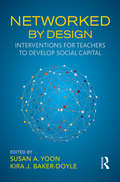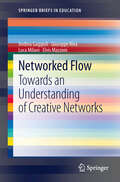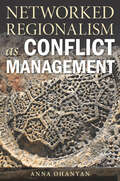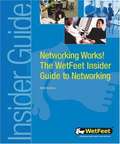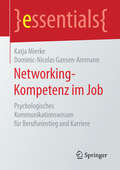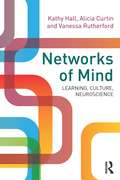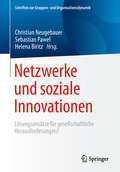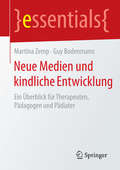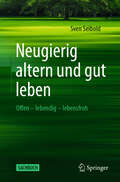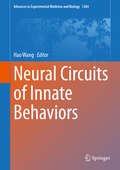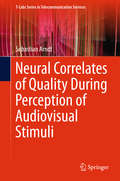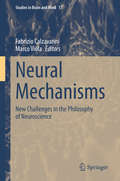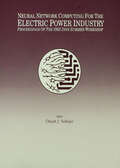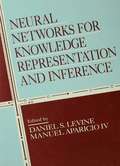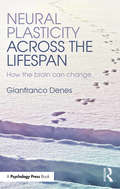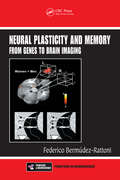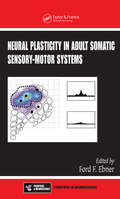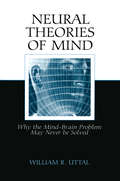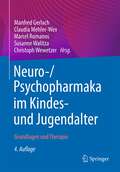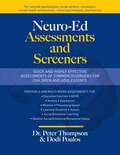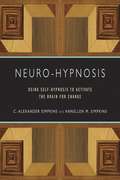- Table View
- List View
Networked By Design: Interventions for Teachers to Develop Social Capital
by Susan A. Yoon Kira J. Baker-DoyleNetworked by Design brings together work from leading international scholars in the learning sciences that applies social network theory to teachers’ social interactions and relationships. The volume examines the direct and indirect relationships and communities that teachers navigate, as well as the models, plans, and other interventions that allow them to exercise control over these networks. Each chapter draws from case studies or latitudinal research to investigate a different intervention and its outcomes. By presenting research conducted in a variety of scales and contexts, this book offers scholars, future teachers, and leaders diverse insights into how interventions in social capital and social networks can create impactful, meaningful teaching and learning.
Networked Flow
by Luca Milani Giuseppe Riva Elvis Mazzoni Andrea GaggioliIdentifying 'networked flow' as the key driver of networked creativity, this new volume in the Springer Briefs series deploys concepts from a range of sub-disciplines in psychology to suggest ways of optimizing the innovative potential of creative networks. In their analysis of how to support these networks, the contributing authors apply expertise in experimental, social, cultural and educational psychology. They show how developing a creative network requires the establishment of an optimal group experience in which individual intentions inform and guide collective goals. The volume represents a three-fold achievement. It develops a ground-breaking new perspective on group creativity: the notion of 'networked flow' as a bridging concept linking the neuropsychological, psychological and social levels of the creative process. In addition, the authors set out a six-stage model that provides researchers with a methodological framework (also by referring to the social network analysis) for studying the creativity traditionally associated with interpersonal contexts. Finally, the book includes perceptive analysis of the novel possibilities opened up by second-generation internet technologies, particularly in social networking, that seem destined to develop and sustain online creativity. As a wide-ranging exposition of a new direction in theoretical psychology that is laden with exciting possibilities, this volume will inform and inspire professionals, scholars and students alike.
Networked Regionalism as Conflict Management
by Anna OhanyanMost regions of the world are plagued by conflicts that are made insoluble by a confluence of complex threads from history, geography, politics, and culture. These "frozen conflicts" defy conflict management interventions by both internal and external agents and institutions. Worse, they constantly threaten to extend beyond their local geographies, as in the terrorist bombings in Boston by ethnic Chechens, or to escalate from skirmishes to full-scale war, as in Nagorno-Karabakh. Consequently, such conflicts cry out for alternative approaches to the classic, state-focused, and sovereignty-based conflict management models that are practiced in traditional diplomacy--which most often produce rather short-term, ad hoc, fragmented interventions and outcomes. Drawing upon the cases of the South Caucasus, the Western Balkans, Central America, South East Asia, and Northern Ireland, Networked Regionalism as Conflict Management offers a theoretical and practical solution to this impasse by arguing for regional collective interventions that involve a long-term reengineering of existing conflict management infrastructure on the ground. Such approaches have been attracting the attention of scholars and practitioners alike yet, thus far, these concepts have rarely involved more than simple prescriptions for regional cooperation between grassroots actors and traditional diplomacy. Specifically, says Anna Ohanyan, only the cultivation and establishment of regional peace systems can provide an effective path toward conflict management in these standoffs in such intractably divided regions.
Networking Works! The WetFeet Insider Guide to Networking
by WetFeetWetFeet has earned a strong reputation among college graduates and career professionals for its series of highly credible, no-holds-barred Insider Guides. This one is on networking, a valuable skill in any industry.
Networking-Kompetenz im Job: Psychologisches Kommunikationswissen für Berufseinstieg und Karriere (essentials)
by Katja Mierke Dominic-Nicolas Gansen-AmmannDie Autoren geben in diesem essential unter R#65533;ckgriff auf evolutions- und wirtschaftspsychologische Modelle einen #65533;berblick #65533;ber Befunde der Karriereforschung, Facetten sozialer Fertigkeit und deren Bedeutung f#65533;r Networking und Besch#65533;ftigungsf#65533;higkeit. Sie fassen Erkenntnisse sozialpsychologischer Studien zur Relevanz pers#65533;nlicher Ziele und zur aktiven Steuerung eigener Verhaltensmuster praxisnah zusammen und machen sie durch #65533;bungen karrierebezogen nutzbar. Auf Basis eines Phasenmodells geben sie Impulse zu Aufbau, Pflege und Nutzung des eigenen Netzwerks und zeigen, wie sich positive Kommunikation auf den Einzelnen sowie auf den Erfolg von Arbeitsteams auswirkt. Das essential schlie#65533;en die Autoren mit weiteren Anregungen zum individuellen Praxistransfer.
Networks of Mind: Learning, Culture, Neuroscience
by Kathy Hall Alicia Curtin Vanessa RutherfordThis ground breaking book is unique in bringing together two perspectives on learning - sociocultural theory and neuroscience. Drawing on both perspectives, it foregrounds important developments in our understanding of what learning is, where and how learning occurs and what we can do to understand learning as an everyday process. Leading experts from both disciplines demonstrate how sociocultural ideas (such as the relevance of experience, opportunity to learn, environment, personal histories, meaning, participation, memory, and feelings of belonging) align with and reflect upon new understandings emerging from neuroscience concerning plasticity and neural networks. Among the themes critically examined are the following: Mind and brain Culture Ability and talent Success and failure Memory Language Emotion Aimed at and accessible to a broad audience and drawing on both schools of thought, Networks of Mind employs case studies, vignettes and real life examples to demonstrate that, though the language of sociocultural theory and that of neuroscience appear very different, ultimately the concepts of both perspectives align and converge around some key ideas. The book shows where both perspectives overlap, collide and diverge in their assumptions and understanding of fundamental aspects of human flourishing. It shows how neuroscience confirms some of the key messages already well established by sociocultural theory, specifically the importance of opportunity to learn. It also argues that the ascendency of neuroscience may result in the marginalization of sociocultural science, though the latter, it argues, has enormous explanatory power for understanding and promoting learning, and for understanding how learning is afforded and constrained.
Netzwerke und soziale Innovationen: Lösungsansätze für gesellschaftliche Herausforderungen? (Schriften zur Gruppen- und Organisationsdynamik #12)
by Ewald E. Krainz Christian Neugebauer Sebastian Pawel Helena BiritzIm vorliegenden Sammelband Netzwerke und Soziale Innovationen wird der Frage nachgegangen, welchen Beitrag Netzwerke bei der Entstehung und Entwicklung von sozialen Innovationen leisten können und wie dies zu Veränderungen in der Gesellschaft führt. In einem Mix aus theoretischen und reflexiven Beiträgen als auch der Darstellung von spannenden Initiativen und Projekten – von den InitiatorInnen selbst anschaulich geschildert –, wird die Thematik praxisorientiert aufgearbeitet. Sowohl PraktikerInnen als auch WissenschaftlicherInnen erhalten wertvolle Hinweise für die Organisation und Entwicklung sozialer Innovationen.
Neue Medien und kindliche Entwicklung: Ein Überblick für Therapeuten, Pädagogen und Pädiater (essentials)
by Martina Zemp Guy BodenmannDieses Essential zeigt, welche Konsequenzen die Nutzung von Fernseher, Computer und Internet für Kinder und Jugendliche hat - und was Fachleute Eltern raten können. Aus wissenschaftlicher Perspektive wird deutlich, dass die Nutzung von gewaltbetonten Medien ein Prädiktor für aggressives Verhalten bei Heranwachsenden ist, neuen Medien ein Suchtpotenzial innewohnt und exzessive Mediennutzung den kindlichen Schulleistungen abträglich sein kann. Entscheidend sind jedoch die Häufigkeit der Nutzung und der Medieninhalt. Vor diesem Hintergrund stehen Eltern in der Pflicht, klare Strukturen bezüglich Form, Inhalt und Dauer der Mediennutzung ihrer Kinder durchzusetzen.
Neue Stimmen in der psychosozialen Forschung
by Stephen FroshDie psychosozialen Studien im Vereinigten Königreich sind ein vielfältiger Arbeitsbereich, der sich durch Innovation in Theorie und empirischer Forschung auszeichnet. Die außerordentliche Lebendigkeit dieses Bereichs zeigt sich in diesem Buch, das die Forschungsarbeiten der Abteilung für psychosoziale Studien an der Birkbeck University of London, UK, vorstellt und drei zentrale Bereiche der Disziplin beleuchtet: Psychoanalyse, Ethik und Reflexivität sowie Widerstand. Das Buch befasst sich auf psychosoziale Weise mit einer Vielzahl von Themen, von der Sozialkritik der Psychoanalyse über postkoloniale und Queer-Theorie bis hin zu Studien über psychische Gesundheit und Widerstand gegen Diskriminierung. Diese "New Voices in Psychosocial Studies" bieten eine kohärente und doch weitreichende Darstellung der Forschung, die in einem "Dialekt" des neuen Terrains der psychosozialen Studien stattgefunden hat, und ein Agenda-setzendes Manifest für einige der Arten von Arbeit, die die fortgesetzte Kreativität der psychosozialen Studien in der nächsten Generation sicherstellen könnten. Dieses Buch zeigt die kontinuierliche Entwicklung der psychosozialen Studien als innovative, kritische Kraft und wird sowohl neue als auch etablierte Forscher aus allen Bereichen inspirieren, die ihren transdisziplinären Ansatz beeinflussen, einschließlich: kritische Psychologie und radikale Soziologie, feministische, queere und postkoloniale Theorie, kritische Anthropologie und Ethnographie und Phänomenologie.
Neugierig altern und gut leben: Offen – lebendig – lebensfroh
by Sven SeiboldSie leben 20 Jahre länger als frühere Generationen. Dieses Sachbuch hilft Ihnen, die gewonnenen Jahre zu nutzen und Ihr Leben im Alter aktiv zu gestalten. Unterscheiden Sie zwischen den Veränderungen, die Sie aktiv beeinflussen können, und solchen, an die Sie sich geschickt anpassen sollten. Ihre Lebensqualität im Alter ist höher, wenn Sie bewusst entscheiden, was gutes Leben für Sie persönlich bedeutet – jenseits von gesellschaftlichen Störfeuern wie Jugendwahn oder Altersdiskriminierung. Das Buch hilft, im Alter lebendig, neugierig und lebensfroh zu bleiben. Aus dem Inhalt: Versöhnen Sie sich mit Ihrer Biografie – gehen Sie respektvoll mit sich um. Orientieren Sie sich an positiven Vorbildern – gutes Altern kann man lernen. Bleiben Sie neugierig – lassen sich von den Chancen des Alters inspirieren. Steigern Sie Ihre Lebensfreude im Alter. Seien Sie fürsorglich zu sich – bleiben Sie körperlich, geistig, emotional und sozial gesund. Treffen Sie wichtige Entscheidungen selbst. Über den Autor: Sven Seibold ist Psychologe und Professor für Wirtschaftspsychologie an der Hochschule Hannover. Seine Arbeitsschwerpunkte sind Entscheidungen, Stress und Persönlichkeit. Er interessiert sich dafür, wie Menschen denken und fühlen, sowie dafür, warum sich Menschen so oft irrational verhalten und wie man das verändern kann. In vielen seiner Arbeiten geht es um Unterschiede zwischen Menschen und darum, wie Menschen lernen, klug zu entscheiden und sich an Veränderungen geschickt anzupassen.
Neural Bases of Timing and Time Perception (Current Issues in Perception)
by Simon Grondin Giovanna MioniNeural Bases of Timing and Time Perception provides a cutting-edge overview of the main contemporary neuroscientific methods and findings in this burgeoning field.Featuring an international collection of leading researchers, this text reports the main methodological tools available to address important questions in the field, what discoveries these tools led to, and what avenues remain to be explored. The book provides concise descriptions of the latest neuroscientific developments about time perception and temporal processing (for instance, how to use TMS or tDCS to study time judgments); and signposts avenues for clinicians to develop new insights for understanding pathologies (as in the case of schizophrenia, for instance) from a temporal perspective.This book will appeal to anyone interested in how we perceive the passing of time, whether from an academic or clinical background.
Neural Circuits of Innate Behaviors (Advances in Experimental Medicine and Biology #1284)
by Hao WangThis book summarizes the latest research findings in the neurocircuitry of innate behaviors, covering major topics such as innate fear, aggression, feeding, reward, social interaction, parental care, spatial navigation, and sleep-wake regulation. For decades, humans have been fascinated by wild animals’ instincts, like the annual two-thousand-mile migration of the monarch butterfly in North American, and the “imprint” behavior of newborn birds. Since these instincts are always displayed in stereotypical patterns in most individuals of a given species, the neural circuits processing such behaviors must be genetically hard-wired in the brain. Recently, with the development of modern techniques, including optogenetics, retrograde and anterograde virus tracing, and in vivo calcium imaging, researchers have been able to determine and dissect the specific neural circuits for many innate behaviors by selectively manipulating well-defined cell types in the brain. This book discusses recent advances in the investigation of the neural-circuit mechanisms underlying innate behaviors.
Neural Correlates of Quality During Perception of Audiovisual Stimuli
by Sebastian ArndtThis book presents a new approach to examining the perceived quality of audiovisual sequences. It uses electroencephalography (EEG) to explain in detail how user quality judgments are formed within a test participant, and what the physiological implications might be when subjects are exposed to lower quality media. The book redefines the experimental paradigms of using EEG in the area of quality assessment so that they better suit the requirements of standard subjective quality testing, and presents experimental protocols and stimuli that have been adjusted accordingly.
Neural Mechanisms: New Challenges in the Philosophy of Neuroscience (Studies in Brain and Mind #17)
by Fabrizio Calzavarini Marco ViolaThis volume brings together new papers advancing contemporary debates in foundational, conceptual, and methodological issues in cognitive neuroscience. The different perspectives presented in each chapter have previously been discussed between the authors, as the volume builds on the experience of Neural Mechanisms (NM) Online – webinar series on the philosophy of neuroscience organized by the editors of this volume. The contributed chapters pertain to five core areas in current philosophy of neuroscience. It surveys the novel forms of explanation (and prediction) developed in cognitive neuroscience, and looks at new concepts, methods and techniques used in the field. The book also highlights the metaphysical challenges raised by recent neuroscience and demonstrates the relation between neuroscience and mechanistic philosophy. Finally, the book dives into the issue of neural computations and representations. Assembling contributions from leading philosophers of neuroscience, this work draws upon the expertise of both established scholars and promising early career researchers.
Neural Network Computing for the Electric Power Industry: Proceedings of the 1992 Inns Summer Workshop (INNS Series of Texts, Monographs, and Proceedings Series)
by Dejan J. SobajicPower system computing with neural networks is one of the fastest growing fields in the history of power system engineering. Since 1988, a considerable amount of work has been done in investigating computing capabilities of neural networks and understanding their relevance to providing efficient solutions for outstanding complex problems of the electric power industry. A principal objective of a power utility is to provide electric energy to its customers in a secure, reliable and economic manner. Toward this aim, utility personnel are engaged in a variety of activities in areas of supervisory control and monitoring, evaluation of operating conditions, operation planning and scheduling, system development, equipment testing, etc. Over the past decades significant advances have been made in the development of new concepts, design of hardware and software systems, and implementation of solid-state devices which all contributed to the steadily improving power system performance that we are experiencing today. Advanced information processing technologies played an important role in these development efforts. Members of the Special Interest Group for Power Engineering of the INNS recognized the need for bringing together leading researchers in the field of neurocomputing with experts from power utilities and manufacturing companies to assess the current state of affairs and to explore the directions of further research and practice. This book is based on The Summer Workshop on Neural Network Computing for the Electric Power Industry which brought together approximately forty specialists with backgrounds in power engineering, system operation and planning, neural network theory and AI systems design. An informal and highly inspiring atmosphere of the workshop facilitated open discussion and exchange of expertise between the participants.
Neural Network Models of Conditioning and Action (Psychology Library Editions: Cognitive Science)
by MICHAEL L. COMMONS; STEPHEN GROSSBERG; JOHN E. R. STADDONOriginally published in 1991, this title was the result of a symposium held at Harvard University. It presents some of the exciting interdisciplinary developments of the time that clarify how animals and people learn to behave adaptively in a rapidly changing environment. The contributors focus on aspects of how recognition learning, reinforcement learning, and motor learning interact to generate adaptive goal-oriented behaviours that can satisfy internal needs – an area of inquiry as important for understanding brain function as it is for designing new types of freely moving autonomous robots. Since the authors agree that a dynamic analysis of system interactions is needed to understand these challenging phenomena – and neural network models provide a natural framework for representing and analysing such interactions – all the articles either develop neural network models or provide biological constraints for guiding and testing their design.
Neural Networks for Knowledge Representation and Inference
by Daniel S. LevineThe second published collection based on a conference sponsored by the Metroplex Institute for Neural Dynamics -- the first is Motivation, Emotion, and Goal Direction in Neural Networks (LEA, 1992) -- this book addresses the controversy between symbolicist artificial intelligence and neural network theory. A particular issue is how well neural networks -- well established for statistical pattern matching -- can perform the higher cognitive functions that are more often associated with symbolic approaches. This controversy has a long history, but recently erupted with arguments against the abilities of renewed neural network developments. More broadly than other attempts, the diverse contributions presented here not only address the theory and implementation of artificial neural networks for higher cognitive functions, but also critique the history of assumed epistemologies -- both neural networks and AI -- and include several neurobiological studies of human cognition as a real system to guide the further development of artificial ones. Organized into four major sections, this volume: * outlines the history of the AI/neural network controversy, the strengths and weaknesses of both approaches, and shows the various capabilities such as generalization and discreetness as being along a broad but common continuum; * introduces several explicit, theoretical structures demonstrating the functional equivalences of neurocomputing with the staple objects of computer science and AI, such as sets and graphs; * shows variants on these types of networks that are applied in a variety of spheres, including reasoning from a geographic database, legal decision making, story comprehension, and performing arithmetic operations; * discusses knowledge representation process in living organisms, including evidence from experimental psychology, behavioral neurobiology, and electroencephalographic responses to sensory stimuli.
Neural Plasticity Across the Lifespan: How the brain can change
by Gianfranco DenesNeural Plasticity Across the Lifespan reviews the recent scientific developments which are transforming our understanding of the human brain. For many years it was thought that modifications to the structural and functional organization of the brain were limited to a short early period of life, "the critical period", and, in adults, to the memory system. Recent research suggests that on the contrary we should see the human brain as a flexible structure, which adapts and modifies in response to learning, sensory experience, age and disease. The book provides an integrated overview of contemporary research on neural plasticity - the process by which the brain can change in structure and function to cope with new experiences and react to the effects of acquired damage or sensory deprivation. It reviews data on plasticity in the developing brain, looking at both typical and atypical development, alongside clinical and observational research on the adult population. It covers a number of key topics, including: different forms of neural plasticity factors affecting neural plasticity (ageing and gender), neural plasticity in language acquisition, memory and bodily self-consciousness mechanisms of repair – plasticity following sensory deprivation and acquired brain damage. This is an accessible overview of an emerging field of research which has fundamental implications for how we perceive our potential to change throughout our lives. It will be essential reading for all students of cognitive development, cognitive neuroscience and lifespan development.
Neural Plasticity and Memory: From Genes to Brain Imaging
by Federico Bermúdez-RattoniA comprehensive, multidisciplinary review, Neural Plasticity and Memory: From Genes to Brain Imaging provides an in-depth, up-to-date analysis of the study of the neurobiology of memory. Leading specialists share their scientific experience in the field, covering a wide range of topics where molecular, genetic, behavioral, and brain imaging techniq
Neural Plasticity in Adult Somatic Sensory-Motor Systems (Frontiers in Neuroscience)
by Ford F EbnerSynthesizing current information about sensory-motor plasticity, Neural Plasticity in Adult Somatic Sensory-Motor Systems provides an up-to-date description of the dynamic processes that occur in somatic sensory-motor cortical circuits or somatic sensory pathways to the cortex due to experience, learning, or damage to the nervous system. The book e
Neural Theories of Mind: Why the Mind-Brain Problem May Never Be Solved
by William R. UttalIn this fascinating book, William R. Uttal raises the possibility that, however much we learn about the anatomy and physiology of the brain and psychology, we may never be able to cross the final bridge explaining how the mind is produced by the brain. Three main classes of mind-brain theory are considered and rejected: field theories, because they are based on a superficial analogy; single cell theories, because they emerge from a massive uncontrolled experimental program; and neural net theories, because they are constrained by combinatorial complexity.To support his argument, Uttal explores the empirical and conceptual foundations of these theoretical approaches and identifies flaws in their fundamental logic. The author concludes that the problems preventing solution of the mind-brain problem are intractable, yet well within the confines of natural science.
Neuro-/Psychopharmaka im Kindes- und Jugendalter: Grundlagen und Therapie
by Manfred Gerlach Claudia Mehler-Wex Susanne Walitza Christoph Wewetzer Marcel RomanosDas Buch vermittelt aktuell und umfassend das Wissen auf dem Gebiet der Neuro-/Psychopharmakologie. Um ein tieferes Verständnis der Therapieprinzipien sowie der Besonderheiten der medikamentösen Behandlung bei Kindern und Jugendlichen zu erhalten, werden im ersten Teil die Grundlagen der Neuro-/Psychopharmakologie dargelegt. Zudem werden rechtliche und ethische Fragen im Praxisalltag eingehend erörtert. Der zweite Teil behandelt ausführlich die verschiedenen Arzneistoffgruppen. Im dritten Teil wird die störungsspezifische und symptomorientierte Medikation praxisorientiert beschrieben und kritisch bewertet, so dass der Arzt über eine klare Handlungsanleitung verfügt. Die vierte Auflage wurde aktualisiert und auf den neusten wissenschaftlichen Stand gebracht. Dieses Nachschlagewerk besticht durch die komprimierte und einheitliche Darstellung mit vielen zweifarbigen Tabellen, Schemata und Abbildungen. Es wendet sich an Kinder- und Jugendpsychiater und -psychotherapeuten, Pädiater, Allgemeinmediziner, Psychologen, Pflegekräfte und Lehrer.
Neuro-Ed Assessments and Screeners: Quick and Highly Effective Assessments of Common Disorders for Children and Adolescents
by Peter Thompson Dodi PoulosNeuro-Ed Assessment and Screeners are fast and effective assessment forms for busy mental health and educational professionals. These practical assessments were created by practitioners who know the needs of professionals working in the field. Th
Neuro-Hypnosis: Using Self-Hypnosis to Activate the Brain for Change
by C. Alexander Simpkins Annellen M. SimpkinsUnderstanding the neuroscience of self-hypnosis for more effective treatment of a variety of conditions. Drawing from over 30 years of teaching, researching, and practicing hypnosis, the authors share systematic instructions, techniques, and exercises for finding your way into a hypnotic trance--or deepen your trance if you've already found it. With exercises specifically tailored to address a wide range of concerns, including stress, depression, substance abuse, anxiety, weight management, fears, and sports performance, this book is a comprehensive guide for anyone interested in hypnosis. The authors synthesize and integrate the major theories of hypnosis and provide an overview of the fundamental tools used in self-hypnosis, especially attention, unconscious processing, and suggestion. For clinicians, they provide evidence and practical considerations that therapists need to incorporate hypnosis into their practice. All readers will benefit from the tips, techniques, and exercises throughout which demonstrate how hypnotic interventions can be tailored to each person. Readers will be inspired to practice at home using hypnotic suggestions that target their specific concerns. Deftly balancing theory and practice, Neuro-Hypnosis provides the tools you need to open yourself to self-hypnosis, experience the vast potential of your mind, and activate your brain for growth, development, and lasting change.
Neuro-Inclusive Community Design: Lessons from Sólheimar Ecovillage
by Charles DurrettThis book is an inspiring exploration of Sólheimar Ecovillage in Iceland, a pioneering community that embodies sustainability, social responsibility, and inclusivity.Cohousing expert Charles Durrett delves into the unique aspects of this ecovillage of about 100 residents, 45 of whom include those with developmental and intellectual disabilities, who live and thrive alongside neighbors in a safe and enriching environment. Through rich storytelling and detailed first-person accounts, the book highlights the importance of creating communities that celebrate and support neurodiversity. Durrett presents Sólheimar as a model for how we can build neuro-inclusive spaces that respect and uplift every individual’s potential, fostering a sense of belonging and purpose. The book offers practical insights into the design, the principles, and the practices that make Sólheimar a standout community for inclusive living. It challenges readers to rethink conventional approaches, advocating for environments where all people, regardless of their cognitive differences, can live meaningful and fulfilling lives. Durrett also presents case studies of four other neuro-inclusive communities, including Hertha Levefallesskab, WeBUILT (We Build Unique Independent Lives Together), Creative Living Community of CT, and L’Arche International Movement. With its focus on real-world solutions and its call to action, this book is both a guide and an inspiration for anyone interested in the intersection of sustainability, community living, and neuro-inclusivity.It will have a broad audience of architects, designers, occupational therapists, mental health professionals, housing developers, and practitioners in housing and social care, among others.
